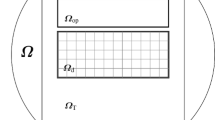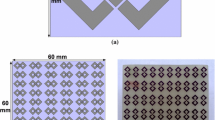Abstract
The critical element of a microwave heating system is the resonator, which affects the effective heating of the material to be heated. It is based on the creation of an effective electric field on the material. In order to create a homogeneous and strong electric field in the entire volume of the material to be heated, it is necessary to design a resonator of the correct dimensions. In this study, a model is derived in which the required resonator dimensions for a microwave heating system with a specific resonance frequency can be calculated analytically. The design of a rectangular microwave resonator that resonates at 2.45 GHz is given purely analytically using a derived model. The extracted analytical model is validated by simulation results for two different modes.




Similar content being viewed by others
Data availability
Enquiries about data availability should be directed to the authors.
References
Sundberg, M., Risman, P.O., Kildal, P.S., Ohlsson, T.: Analysis and design of industrial microwave ovens using the finite difference time domain method. J. Microw. Power Electromagn. EnergyMicrow. Power Electromagn. Energy 31, 142–157 (1996)
Wäppling-Raaholt, B., Risman, P.O., and Ohlsson, T.: Microwave heating of ready meals FDTD simulation tools for improving the heating uniformity. In : M.Willert- Poprada (Ed). Advances in Microwave and Radio Frequency Processing. 243- 255. Springer Berlin Heidelberg (2006)
Dibben, D.C., Metaxas, A.C.: Time domain finite element analysis of multimode microwave applicators loaded with low and high loss materials. IEEE Microwave and Guided Lett. 32, 945–948 (1996)
Dibben, D.C., Metaxas, R.: Frequency domain vs. time domain finite element methods for calculation of multimode cavities. IEEE Transact. Magn. 33, 1468–1471 (1997)
Kalganova, S. G., Trigorly,and S. V., Zakharov, V.: Computer simulation of microwave heat treatment of dielectrics. 2018 IV International Conference on Information Technologies in Engineering Education (Inforino)
Li, C.N., Lin, X.Q., Liu, D.Y., Wen, Z.: Regionally tunable microwave heating technology using time-frequency-space domain synthesis modulation method. IEEE Transact. Ind. Electron. 68(10), 10240–10247 (2020)
Pedreño-Molina, J.L., Monzó-Cabrera, J., Pinzolas, M.: A new procedure for power efficiency optimization in microwave ovens based on thermographic measurements and load location search. Int. Commun. Heat Mass TransferCommun. Heat Mass Transfer 34, 564–569 (2007)
Requena-Perez, M.E., Pedreno-Molina, J.L., Monzo-Cabrera, J., Diaz-Morcillo, A.: Multimode cavity efficiency optimizitation by optimum load location-experimental approach. IEEE Trans on Microwave Theory and Techn. 53, 2144–2120 (2005)
Kopyt, P., Celuch-MarzYsiak, M.: FDTD modelling and experimental verification of electromagnetic power dissipated in domestic microwave ovens. J. Telecommun. Inf. Technol. 1, 59–65 (2003)
Jia, X.: Experimental and numerical study of microwave heating applicator. J. Microwave Power and Elecromagn. Energy 28, 25–31 (1993)
Monzó-Cabrera, J., Díaz-Morcillo, A., Pedreño-Molina, J.L., Sánchez-Hernández, D.: A new method for load matching in multimode-microwave heating applicators based on the use of dielectric-layer superposition. Microwave Opt. Technol. Lett. 40(4), 318–322 (2004)
Pedreno-Molina, J.L., Monzo-Cabrera, J., Catala-Civera, J.M.: Sample movement optimization for uniform heating in microwave heating ovens. Int. J. RF Microwave Comput. Aided Eng.Comput. Aided Eng. 17, 142–152 (2006)
Kashyap, S.C., Wyslouzyl, W.: Methods for improving heating uniformity of microwave ovens. J. Microw. Power Electromagn. EnergyMicrow. Power Electromagn. Energy 12, 223–230 (1997)
Domínguez-Tortajada, E., Monzó-Cabrera, J., and Díaz-Morcillo, A.: Uniform Electric Field Distribution in Microwave Heating Applicators by Means of Genetic Algorithms Optimization of Dielectric Multilayer Structures. IEEE Transactıons on Microwave Theory and Techniques, 55 (2007)
Plaza-González, P., Monzó-Cabrera, J., Catalá-Civera, J.M., Sánchez-Hernández, D.: New approach for the prediction of the electric field distribution in multimode microwave heating applicators with mode stirrers. IEEE Trans. Magn.Magn. 40, 1672–1678 (2004)
George, J., Bergman, R.: Selective re-meshing: A new approach to include mode stirring effects in the steady state FDTD simulation of microwave heating cavities. Microw. Opt. Technol. Lett.. Opt. Technol. Lett. 48, 1179–1182 (2006)
Pitarch, J., Canós, Peñaranda-Foix, F.L., Catalá-Civera, J.M., and Balbastre, J.V.: Synthesis of uniform electric field distributions in microwave multimode applicators by multifeed techniques. Proc. 9th Conf. Microwave & High-Frequency Heating, Loughborough, U.K., 221–224 (2003)
Süle, O., Kent, S.: Analysis of microwave cavity loaded with lossy dielectric slab by means of mode matching method and optimization of load location. PIER M 14, 71–83 (2010)
Chongcheawchamnan, M., Patisang, S., Srisathit, S., Phromloungsri, R., Bunnjaweht, S.: Analysis and design of a three-section transmission-line transformer. IEEE Transact. Microwave Theory Tech. 53, 2458–2462 (2005)
Yuan, S.Z.: An analysis of the loading effects of the box-type microwave applicator. J Microwave Power 15, 155–167 (1980)
Funding
The authors have not disclosed any funding.
Author information
Authors and Affiliations
Contributions
OS and SK wrote the article with equal contribution.
Corresponding author
Ethics declarations
Conflict of interest
The authors have not disclosed any competing interests.
Additional information
Publisher's Note
Springer Nature remains neutral with regard to jurisdictional claims in published maps and institutional affiliations.
Appendix
Appendix
Phase constant of free space:
Cutoff frequencies of the transverse electric (TE) and transverse magnetic (TM) modes:
The phase constants for the resonator and the waveguide are as shown in the following equations.
The loss tangent can be expressed as above.
\(\gamma\) is the propagation constant of the loaded resonator; (\(\alpha ^{\prime}\) is the attenuation constant, and \(\beta ^{\prime}\) is the phase constant)
For TE type modes, the wave impedance for the material and the free space of the resonator can be defined as follows:
where zer is the wave impedance of the material, and zl is the wave impedance of the empty space of the resonator.
Rights and permissions
Springer Nature or its licensor (e.g. a society or other partner) holds exclusive rights to this article under a publishing agreement with the author(s) or other rightsholder(s); author self-archiving of the accepted manuscript version of this article is solely governed by the terms of such publishing agreement and applicable law.
About this article
Cite this article
Süle, O., Kent, S. Highly efficient slab-loaded microwave resonator design: analytical solution and numerical validation. J Comput Electron (2024). https://doi.org/10.1007/s10825-024-02150-z
Received:
Accepted:
Published:
DOI: https://doi.org/10.1007/s10825-024-02150-z




